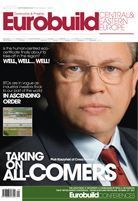Well, well... Well!
Green projects
According to the Polish Green Building Council (PLGBC), by March this year there were 551 buildings of various types in the country with a total useable area of more than 10 mln sqm that had qualified for environmental certification. The vast majority of these (more than 8 mln sqm) has undergone BREEAM certification, while LEED is in second place (1.6 mln sqm) with DGNB trailing far behind (200,000 sqm) and HQE lagging even further with around 30,000 sqm. The proportions are similar in terms of the numbers of certified buildings: BREEAM – 443, LEED – 103, HQE – 4 and DGNB – 1. How has this wide variance in distribution arisen?
“The BREEAM and LEED systems enjoy the most popularity, mostly because they were the first to enter the international market, while the other two are still trying to establish themselves,” points out Rafał Schurma, the president of the Polish Green Building Council. “Another important factor is that there are fewer companies behind the HQE and DGNB systems, their funds are smaller and, as a result, so are their marketing budgets,” he adds.
The first LEED certificate was awarded in January 2010 and the first BREEAM was issued just five months later. HQE certification had to wait until March 2015 to make its first appearance, followed by DGNB in September 2016. Interestingly, the oldest certified building in Poland dates back to 1725: the Palace of the Oppersdorf family, which has been integrated into the Dominikański office complex in Wrocław. Certificates have also been awarded to nine other buildings erected before 1954: six are located in Warsaw and one each in Kraków, Poznań and Wrocław. “There are many historic buildings that have already been certified or are going through the certification process: Le Palais, Hala Koszyki, EC Powiśle, Koneser, Mazowiecka 4/2, Monopolis...,” says Marcin Gawroński, the director of BREEAM/LEED at Sweco Consulting. “However, the decision over whether to certify or not is more related to the future function of the building and less related to its age. I think that the building’s age is not a significant barrier in the way of acquiring a certificate. If we are talking about revitalisation, we are introducing new quality to the building, particularly in terms of the installations and interior finishing.
New kid in town
The four main assessments have now been joined by another system under the name of The Well Building Standard, or just Well, for short. “It is complementary to other systems and what sets it apart is the fact that it is 100 pct focused on the human being – on their comfort, physical and mental health – whereas other systems devote only up to around 15–20 pct on these issues,” explains Rafał Schurma. As with the older systems, Well has emerged in Poland thanks to developers that hail from abroad. In January this year, HB Reavis was the first to announce a project designed to fulfil Well requirements: the Varso office complex, which is to be built on ul. Chmielna in Warsaw. In June the same developer started the construction of the first stage of the Stanica Nivy mixed-use complex in Bratislava (with a total useable of over 130,000 sqm), the first project in Slovakia designed to obtain a Well core and shell certificate at the ‘Gold’ level.
“For many years developers have mostly applied for environmental certificates to confirm the fact that their buildings feature reduced raw material usage, carbon dioxide emissions and waste generation. This is very important, but these are long-term goals and rather abstract for the average Joe Public,” points out Stanislav Frnka, the CEO of HB Reavis Poland. The Well Building Standard is partly based on medical knowledge and therefore is a certificate that people can relate to better – one that enables us to evaluate the impact of a given place on the health and well-being of the people using it. The attention to these details is an increasingly effective weapon for our tenants in the battle to attract and retain the most talented personnel. In the case of Varso, Well is also perfectly in line with the character of the entire project, which is exceedingly open to the city and people, going well beyond the standards of a typical business centre,” argues Stanislav Frnka.
In April Skanska announced that it would be applying for a Well certificate for its Spark office park development on Serek Wolski, between ul. Towarowa and ul. Okopowa in Warsaw. Furthermore, Skanska is planning to certify projects in the Czech Republic, Romania and Hungary under this system. “In 2009 we were the first developer in the CEE region to take the decision to build all our facilities in line with the requirements of LEED certification, and this warmed both office tenants and investors alike to the idea of sustainable buildings,” claims Katarzyna Zawodna, the managing director of Skanska Commercial Development Europe, with some pride. “But now that LEED has established itself as a standard, we are going one step further and setting another sustainable trend,” she adds. However, other developers have also been cottoning on to the new system and the training of Well auditors (The Polish Green Building Council already has three licensed people and Sweco has one) has now begun. “In spite of the fact that we already have the first few authorised people and the first few building applications, Well in Poland is still rather like the yeti – everyone talks about it but nobody has actually seen it,” remarks Rafał Schurma, only half-seriously.
Cake slicing
It is hard not to believe that the emergence of another multi-criteria system will add to the competition in this field. Will investors’ shifting to Well shake the foundations (particularly the financial ones) of the other systems? “I would not call it competition. ‘Coopetition’ [the simultaneous cooperation and competition between rivals, editor’s note] would a more appropriate word,” argues Rafał Schurma. “All multi-criteria assessment systems learn from each other and have an impact on each other’s performance as they hit the market – and this is a positive phenomenon. There is enough room on the market for all five of them,” he adds. The civil relations between multi-criteria systems are confirmed by the International Well Building Institute (IWBI), the institution that devised Well and that is responsible for its certification. “Since the very beginning, IWBI has strived for Well to cooperate in harmony with the other standards, such as LEED and BREEAM,” insists Rick Fedrizzi, the president and CEO of IWBI. “Furthermore, in order to promote sustainable development and health even more, IWBI encourages certification with LEED and other systems in addition to Well. Such an approach encourages buildings to be designed in line with the highest global standards. For an example of harmonious co-existence, when a LEED certificate attests to an office building’s low water consumption, a Well certificate can then be obtained to determine its water quality,” argues Rick Fedrizzi.
Interestingly, Well is the only multi-criteria standard for new buildings that has to be renewed every few years. The owner could lose the certificate if the quality of the air, water or lighting deteriorates in their building or the surroundings of the property worsen. Admittedly, the LEED EBOM (existing buildings operation and maintenance) and BREEAM In-Use systems (both devised for existing buildings) also require periodical evaluation, but as far as buildings or interiors designed or built from scratch, LEED and BREEAM certificates are awarded without the obligation of renewal (even though they have an expiry term).
With a calculator in hand
The costs for obtaining and maintaining a certificate in each of the systems are not easy to estimate, mostly because their price depends on a number of variables, including the area, the function, the standard and age of the property, the methods and materials used as well as the rating of the certificate the investor applies for (the more ambitious, the more expensive of course). It is also possible to either certify the entire building or a single floor or office of a particular tenant.
Officially, the preliminary costs for Well start with the online project registration fee – from USD 1,500 to 10,000, subject to the amount of space and type of property. The IWBI internet service also provides a virtual calculator to estimate the bill issued by the US certifying unit to the investor for their services: the price includes a training session, coaching and support from IWBI Technical Solutions, complex documentation analysis, an inspection of the project combined with an evaluation of the application and the tests required, as well as the marketing and PR support. For example, for an app. 10,000 sqm building the estimated cost of certification in the core and shell category is just under USD 24,000, whereas a certificate for the same property at the new and existing buildings level would cost more than USD 62,000. Pre-certification (i.e. the audit of documents at the design stage) has a separate price list (this is a fixed rate: USD 15,000, but with a discount option) – as does the re-certification (i.e. a new audit, the cost of which is subject to the amount of the original fee, among other factors).
However, this is not the end of the list of expenses – a local consultant also has to be paid who (as in the case of the other systems) will issue a bill for the audit amounting to a several tens of thousands of złoty (most likely in the PLN 50,000–100,000 bracket); there will also be additional analyses and reports on top of that, which will cost from PLN 40,000 up to PLN 60,000. But the costs of analysing the technical methods that have been or are to be implemented in the building process are virtually impossible to estimate.
Unsurprisingly, investors in the Polish property market are trying to reduce certification costs. But because it is possible for just a single floor of a building to be audited, one way to save costs is to have this done with a show area. Since the concept of preparing and certifying a show-floor for marketing purposes is already a popular one in this country, the idea is to say to the potential tenant: “Look, this is a sample office, which we have certified under the Well system. We will be able to prepare an identical one for you.” And this approach would certainly be appreciated by shareholders.
A long and winding road
“I think that as far as the volume of certifications is concerned, the Well system will position itself somewhere in the middle of the Big Five,” believes Marcin Gawroński of Sweco Consulting. “Investors will choose one of the systems that have been present on the market for longer and assess the entire building, auxiliary infrastructure and environmental impact, whereas Well will be a kind of additional option for projects that have already been BREEAM or LEED certified. Well’s role will be to emphasise the uniqueness of the project and its additional functions, which are not evaluated by other systems,” he predicts.
WELL-NESS AND WELL-BEING
The Well Building Standard focuses exclusively on the health and well-being of a building’s users. The system assesses and monitors those aspects related to the property and its indoor environment that have a significant impact on the users of the building. Well covers seven such aspects: air, water, nutrition, light, physical condition, comfort and mind. The aspects are divided into 102 characteristics that are assessed for each project.
Well certificates are awarded in the following categories:
new and existing buildings
new and existing interiors
core and shell compliance
For the first two categories it is possible to obtain ‘Silver’, ‘Gold’ or ‘Platinum’ ratings, while a core and shell compliance label is issued for the third category.
Source: Polish Green Building Council
Katarzyna Zawodna
the business unit president of Skanska Commercial Development Europe
Well is not a promise but a guarantee
Who needs Well certification – developers, leasing companies, their employees?
All of those you mentioned – although I would have reversed the order. It is a highly comprehensive assessment, which, like no other system, focuses on the comfort and well-being of the human user.
LEED or BREEAM also cover the comfort of work and the health of the staff. Why are they not good enough?
This is true. LEED, one of the most popular certification systems in the world, analyses the building’s impact on the environment and takes into account many factors that have an impact on human well-being (e.g. the indoor environment). However, Well has mainly been devised for the building’s users. The system does contain some seemingly softer aspects, but they turn out to be those that influence people’s comfort and health to a greater extent. Well also takes into consideration such factors as the quality of food offered in the building.
What are the particular benefits provided by Well for the owner and tenant?
Studies show, for example, that employees’ concentration is improved by as much as 66 pct if they work in a room with the right acoustics. And if the quality of the air is higher, then there Is also a correspondingly lower amount of sick leave. Well assesses whether we can work more effectively and healthily. Besides, the certificate is not a promise but a guarantee that such guidelines are adhered to – the certifying unit requires from the building owner verification that the initial standards are met every three years, thanks to which the tenant can be sure that the high quality of the building’s interior will remain the same for many years to come.
Which specific projects will you be certifying with this assessment in the near future?
One of the first buildings we are certifying under the Well standard in Poland will be Spark, which we are developing in Warsaw’s Wola district. Other Skanska projects in Poland and he CEE region are already being adapted to fulfil the criteria of the Well system.





















































